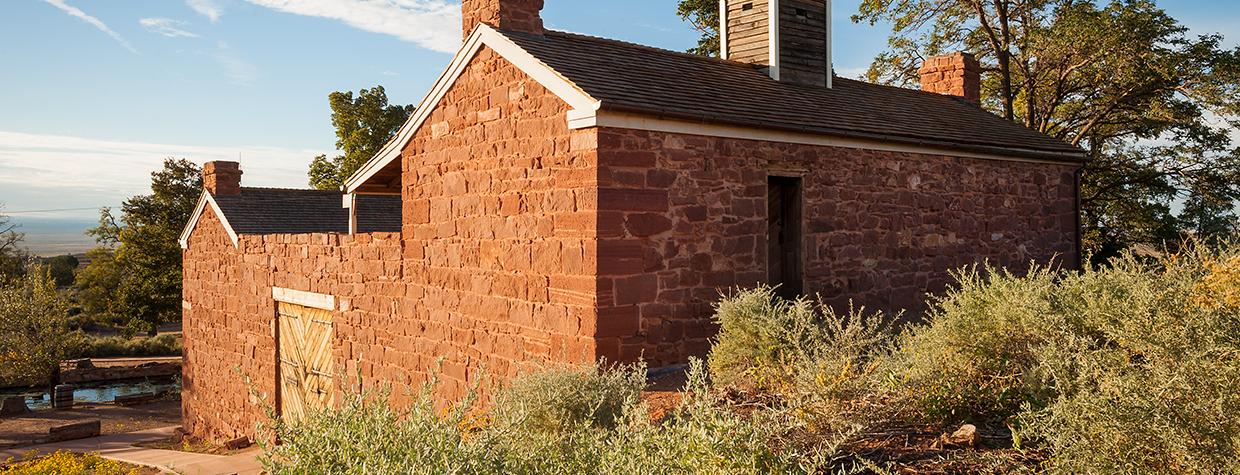Reliable water in the desert, the only such oasis for miles around, has given Pipe Spring a rich history that includes Indigenous peoples, Brigham Young and John Wesley Powell. The presence of running water also led to the creation of Pipe Spring National Monument nearly a century ago — but not for the reason you might expect.
“It was established more or less as a bathroom stop,” says Ian Harvey, the monument’s lead interpretive ranger. “At that time, if you wanted to visit national parks, you joined a touring company and they bused you from park to park.” And Pipe Spring, roughly four and a half hours from both Zion National Park and the Grand Canyon’s North Rim via the primitive roads of the time, made sense as a place to, as Harvey puts it, “stretch your legs, eat a sandwich, drink some water and move on.”
Today, the 40-acre monument, which will celebrate its centennial next year, is much more than a pit stop. And although it isn’t as well known as the larger National Park Service sites that surround it, that often becomes part of its appeal. “Generally, people who visit see the brown sign on the highway and say, ‘What is this place?’ ” Harvey says. “They come in with questions already, and that leads to in-depth conversations.”
People have been using the spring since prehistory. Ancestral Puebloans gathered there, and the Kaibab Paiutes’ origin story places them in the area. Spanish explorers passed through the region, and their cattle may have grazed on spring-fed grasses. After them came Mormon settler James Whitmore, who founded a ranch at Pipe Spring in the 1860s.
After Whitmore and his ranch hand went out to check on their cattle and later were found murdered, Young, the longtime Church of Jesus Christ of Latter-Day Saints president, bought the Pipe Spring deed from Whitmore’s widow and ordered that a fort be constructed over the water source. He even paced the outline of the building himself, although the resulting building ended up being about half the size Young had imagined.
That building was Winsor Castle, completed 150 years ago this year. Designed as both a headquarters for a Mormon tithing ranch and a refuge from Navajo attacks, the fort was named after its first manager, Anson P. Winsor — and legend has it that the name came from Powell, the intrepid Canyon explorer, when he stayed there and remarked to Winsor, “You built yourself a heck of a castle here!” The fort’s design included a lookout tower and gunports, but the building never came under attack.
Today, Winsor Castle looks virtually the same as it did a century and a half ago. Almost all of its stonework is original and displays its builders’ drill and chisel marks. Some of its original lumber came from Mount Trumbull, 40 miles to the southwest — and while much of that wood has been replaced, other pieces display the brands and initials of cattlemen who passed through over the decades. In the fort’s rooms, you’ll find a vintage stove, ordered by one of the caretakers’ wives in the 1880s, and Arizona’s first telegraph station, which connected to the Deseret Telegraph Co. network in Utah.
As for the spring, its water still bubbles from under the floorboards in the parlor and flows under the courtyard before emptying into a trough, then filling two ponds outside. Its current flow of 4 to 5 gallons per minute is a fraction of its historical volume, but it’s enough to attract migratory birds and nurture fruit trees and grapevines in the downstream orchard. Also at the site are an interpretive hiking loop, a garden where plants are grown via both pioneer and traditional Indigenous methods, and various livestock, including Whitmore, a Texas longhorn similar to those ranched at Pipe Spring in the early days. And the visitors center and museum, on Kaibab Paiute land leased from the tribe, offers permanent and rotating exhibits.
Despite all this, the monument remains one of the Arizona Strip’s best-kept secrets. In 2019, the most recent year not affected by COVID-19 restrictions and closures, Pipe Spring saw 27,482 visitors — an average of about 75 per day. But Harvey says that presents a unique opportunity for the monument’s staff. “We’re able to meet and talk with all of the visitors, and we’ll get to know their interests very quickly,” he says. “At larger parks, you get a brochure and you’re sent on your way. We’re able to do a lot of different things here, whether it’s interpretive programming, tours of the fort or demonstrations. We can take that extra step that you might not see at the larger parks.”
And that’s been well received by visitors, some of whom have deep personal ties to the site. “A large portion of visitors are the great-great-great-so-and-so of someone who was born here,” Harvey says. And on a recent Saturday afternoon, descendants of the first Park Service caretaker and a rancher from the 1800s stopped by.
But you don’t have to be family to have a meaningful experience at Pipe Spring. “There’s so much history here,” Harvey adds. “Anyone who visits can find something that interests them. If you’re curious enough, you’ll find a connection.”
To learn more about Pipe Spring National Monument, call 928-643-7105 or visit nps.gov/pisp.

